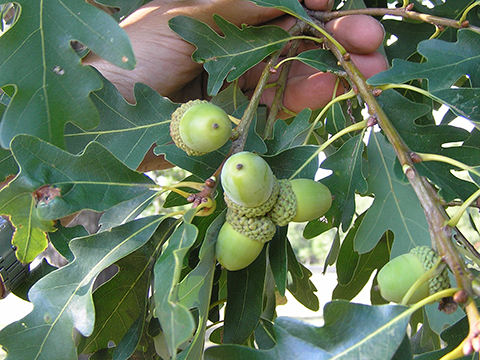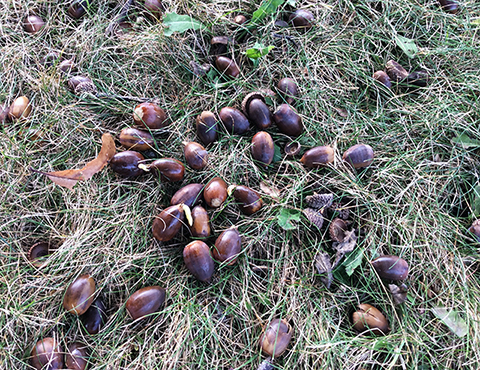 |
| Home | Ordering By Mail | Purchase Manual: Using Native Plants in Urban Landscapes |
|
|||||
Species Name: Quercus alba
Common Name: White oak
Zone: 3 to 9
Distribution: Found from southern Quebec Canada and Maine south through the eastern US to northern Florida extending westerly to eastern Texas
Seed collection: Seed collection should begin in early to mid September in New York State. Quercus alba (QA) acorns produce their acorns during one growing season. The flowers are pollinated in the spring, develop over the summer, maturing in early fall. Seed production will vary considerably from year to year. Bumper crops are produced every 5 to 7 years with smaller crops or no crop at all produced during the intervening years. Open grown trees will produce fairly consistent acorn crops each year compared to forest grown trees. Acorns can be harvested directly from the tree or collected from the ground. Trees with low branches help facilitate collection directly from the tree and ensure a higher percentage of sound seed. There is a wide variation between trees in their production of acorns. Some trees produce so many acorns that it literally can rain acorns while other trees produce only a hand full.
The acorns will naturally separate from the acorn cap as they mature and fall to the ground. White oak acorns tend to be egg shaped. Sound acorns will have a light cream colored acorn cap scar and shiny chocolate brown skin. The acorn changes color from a light green late in August gradually changing color through yellow to a dark chocolate brown color at full maturity. Acorns changing color will often have a mottled appearance. Many species of insects feed on acorns both on the tree and on the ground. Look for small round exit holes where weevils have emerged and discard these acorns. Insect feeding usually results in failure of the acorn to germinate. Acorns that have fallen prematurely or have their cap attached to them are usually not viable and should be discarded.
Seed handling: As QA acorns germinate immediately they cannot be stored very long and should be planted immediately in containers or where you want them to grow. A float test can be used to separate sound viable seed from unsound seed. Many acorns will be infested with acorn weevil larvae. Float the acorns in a pail of water. Sound seeds will sink to the bottom while insect infested acorns will float or be semi-buoyant. Soaking the acorns in water for one to two days will kill any remaining insects. Discard any acorns that float or have exit holes in them. QA acorns are know to be low in tannins and therefore are desirable by wildlife. QA quickly converts the stored carbohydrates contained in the acorn into living root tissue and therefore has little need of the tannins to protect the acorn from herbivory. Even though the stored food in the acorn is turned into living plant tissue it is still a prized meal for small rodents and they will dig up any germinating seedlings they can find for a nutritious springtime meal.
Germination requirements: QA acorns will begin to germinate immediately after they have fallen to the ground. A root radicle will emerge form the acorn and the root tip will follow the force of gravity. The root elongates very rapidly and can reach several inches in length and will begin to establish lateral roots. The new shoot will not emerge until spring, after it has undergone a two to three month chilling period. A word of caution, acorns that have sprouted in storage and are disturbed from their original position will develop twisted contorted roots as the root tip continually tries to follow gravity. Sow acorns in the fall 1” to 2” deep in prepared seed beds, individual containers or in natural soil. It is best to plant the acorn before it begins to sprout. The deep root system helps the seedling cope with drought and competition from weeds but this also makes seedlings extremely difficult to dig and survive transplanting. As seedlings, the root system is far larger and more developed than the above ground shoot. For this reason it is best to plant acorns where you want them to grow and not try to transplant them. Grow oaks for transplanting in deep containers or root prune the roots one season before digging for ease of digging and transplant survival.
Quercus alba seedlings will grow in full sun to half shade. Seedlings can be established in old fields, shrubland and young successional forest. Oak seedling establishment is best where herbaceous surface vegetation is sparse and shrubs and young trees are becoming established to reduce the risk of vole predation. Oak seedlings are readily eaten by meadow voles, rabbits and deer so protection from herbivory as a seedling is strongly recommended.
Ecology: Quercus alba (QA) is a large long-lived forest tree growing to a height of 70 to 90 ft high and 2 to 3 ft in trunk diameter. Quercus alba commonly lives to an age of 300 to 400 years fi given enough time. QA grows fairly fast as a young tree but fairly quickly growth slows down with age. QA ranks near the bottom of all of the oaks in its rate of growth.
QA will grow in any well drained soil and tends to favor drier gravelly upland sites with adequate moisture and nutrients. It is a component of several forest types growing in association with a number of other tree species, other oaks, hickory sugar maple, basswood and white pine. It does not like poorly drained conditions and will develop root rots where the soil moisture remains too high.
Quercus alba requires more sunlight than other oak species for seedling establishment. It tends to get established in old fields and forest margins where more sunlight is available. Open grown specimens will have large broad spreading branches. The canopy can be as wide as the tree is tall. Trees competing for sunlight will develop tall clear boles with few lower branches. Branches growing in shade have a tendency to self prune.
Quercus alba is prized for its wildlife value. Although it may take 20 to 30 years for the tree to begin to produce sufficient mast for wildlife, the acorns are a preferred food during the fall when the acorns first drop. But unlike other oak species whose acorns may remain uneaten until spring, all of the acorns of White oak will be devoured soon after they have fallen or they will germinate and convert their stored energy into living root.

Acorns just before they are ready to turn color and drop.

Acorns on the ground just shortly after falling. Note the dark brown color of viable acorns
and some acorns with the root emerging. Fall is the time to collect and plant white oak acorns.
White oak acorns freshly collected from a tree in various stages of color change from light green to chocolate brown.
Sound acorns with bright shiny white acorn cap scars. This is a good indication of viable acorns.
Weevil infested acorns with dull discolored acorn cap scars, a good way to separate unsound acorns from viable ones.
This page updated February 25, 2015